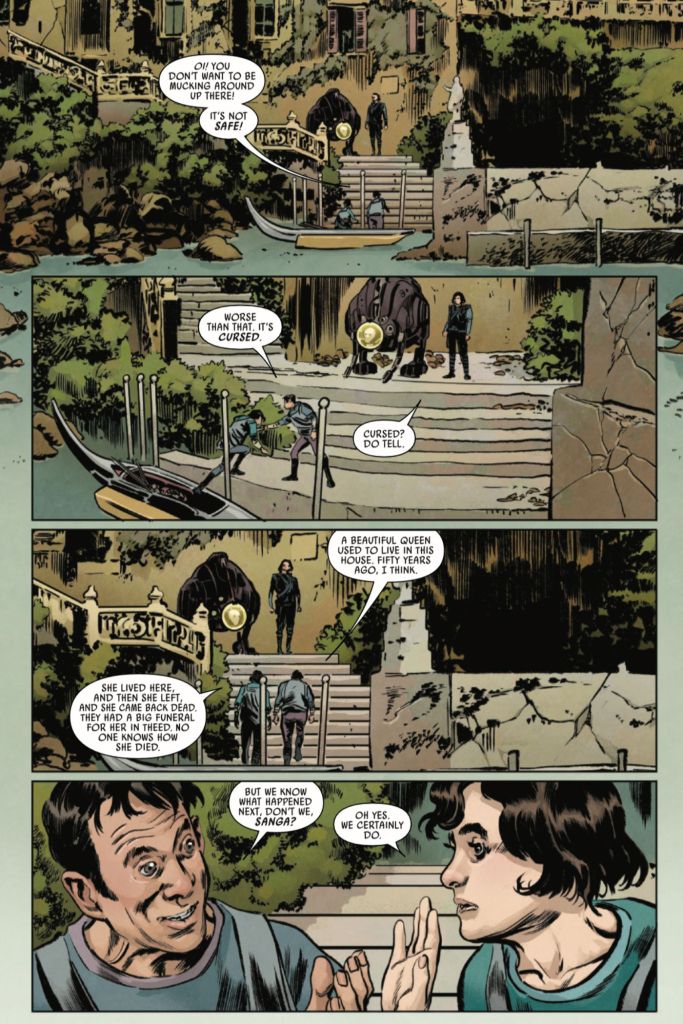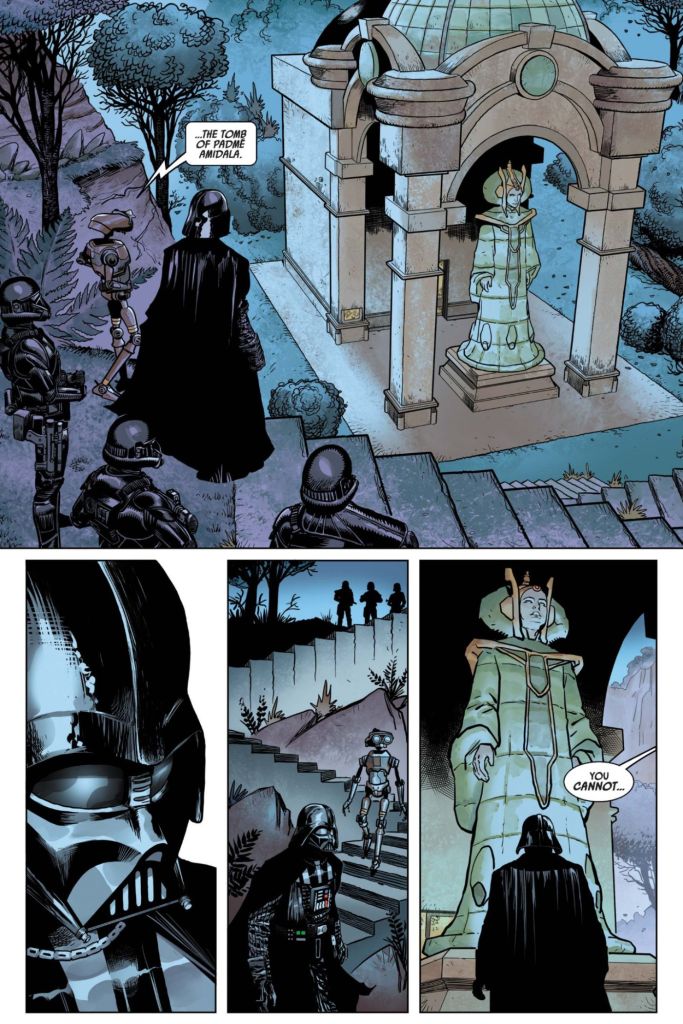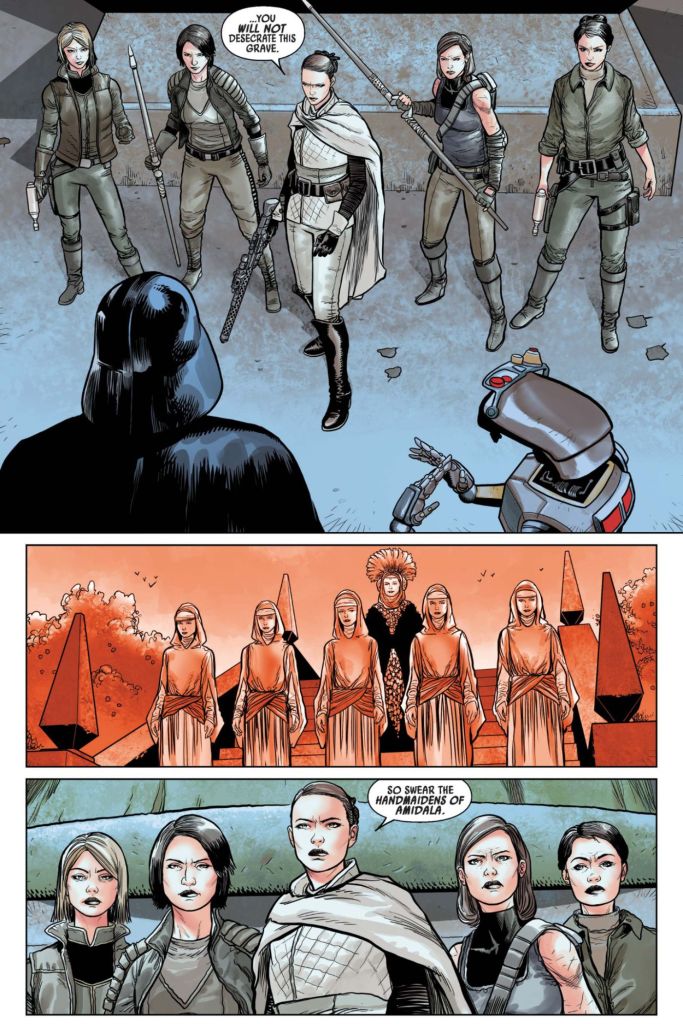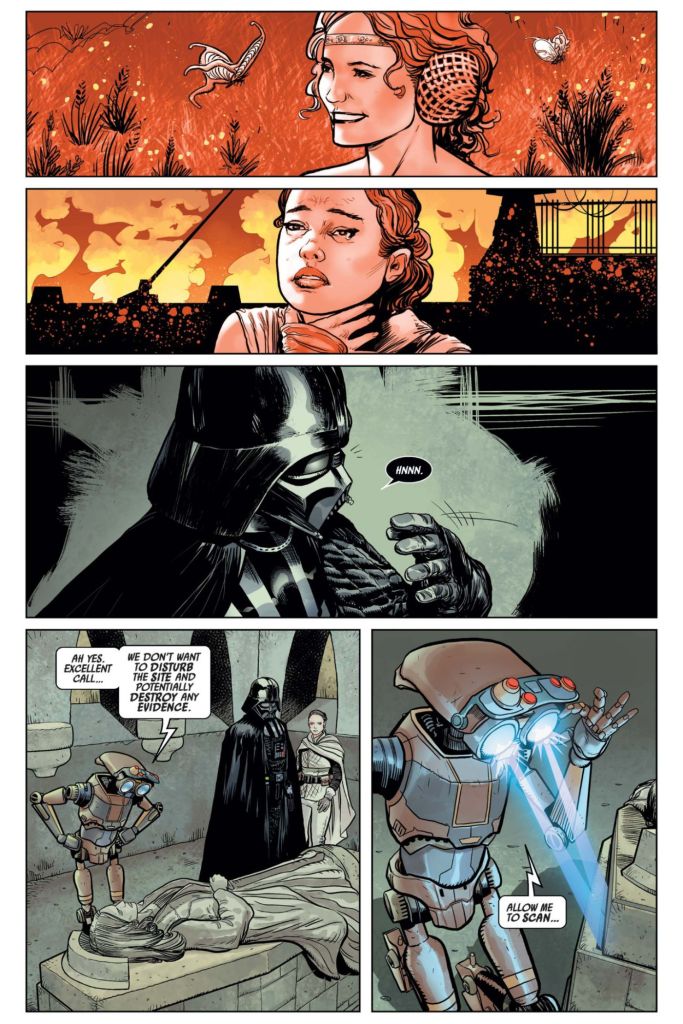Naboo, a planet of serene beauty, bears the indelible scars of galactic conflict, none more profound than the shadow cast by Darth Vader. For its inhabitants, the mere mention of Vader’s presence evokes images of widespread destruction, a horrifying visitation by a “spirit of death” that swept across their world, leaving ruin in its wake. Yet, amidst the dying landscapes and shattered monuments, one sacred place remained preserved: Padmé Amidala’s tomb. This untouched sanctuary, a testament to a love buried beneath layers of hatred and pain, offers a poignant glimpse into the fractured soul of Anakin Skywalker — a humanity that even the monstrous persona of Darth Vader could not entirely extinguish. The first time Vader comes upon Padmé’s tomb is a moment of deep and utter sadness, where the reader can feel the tremor of agony beneath the chilling mask; a harsh contrast to the widespread devastation he wrought elsewhere on the planet.
Videos by ComicBook.com
Vader’s Destructive Rampage Across Naboo Was Fueled by Unbearable Grief and Rage


In the latest issue of Star Wars: Legacy of Vader #4 by Charles Soule and Luke Ross, Kylo Ren visits Naboo, showing the once gorgeous palace that belonged to Padmé had become a harrowing scene of devastation. The local children tell Kylo Ren about a “spirit of death” visiting the palace that had once been home to “a beautiful Queen” and destroying anything related to her. Not only that, but the “spirit” hunted people who spoke of her at all or acknowledged the fact that she ever lived at all, leaving the palace as a place of fear that people no longer visited.
RELATED: Star Wars Already Proved This Forgotten Phantom Menace Character Deserves Their Own Sequel
The truth behind the desecration of Padmé’s palace is revealed in Darth Vader (2020) #4-5 by Greg Pak and Raffaele Ienco. Upon learning that his son had somehow lived, Vader sets out on a mission to learn anything he can about the circumstances surrounding the birth of his child (children, unbeknownst to him) and Padmé’s death. Vader’s investigation eventually leads him to Naboo, where he rampages across the planet in an act of pure, unbridled grief and rage; a desperate attempt to excise the pain of his past. Yet, when confronted by Padmé’s loyal handmaidens at her tomb, his destructive fury halts, revealing a deeply buried flicker of the man he once was: Anakin Skywalker.


Darth Vader’s destruction of Padmé’s palace on Naboo in Darth Vader is not a strategic maneuver and serves no purpose; instead, it is a primal scream of anguish. The beautiful world where Anakin Skywalker and Padmé Amidala’s love blossomed and where they were wed, becomes the unfortunate canvas for his internal torment. The “spirit of death” that locals describe in Legacy of Vader is less a calculated destroyer and more a manifestation of overwhelming pain. He tears through the palace and its grounds, each act of destruction a futile attempt to obliterate the memories that haunt him.
This rampage is an act borne out of pure pain and a desperate attempt to sever the last bits of Anakin Skywalker that grieve within him. Every laser blast, every crushing Force grip, is a blow against the tenderness he once felt — a brutal self-punishment for the choices that led to his suffering. The destruction of Naboo is not about asserting Imperial dominance at all; it’s about Vader trying to destroy the memories of a life that ended in tragedy and heartbreak. He is raging against the Force itself, against the universe that allowed such pain to be inflicted upon him, and against the lingering hope he once held for a different future.
Padmé’s Untouched Tomb Represents a Last Glimmer of Anakin’s Humanity

Amidst the widespread devastation, one place on Naboo remained safe: Padmé Amidala’s tomb. When Vader’s destructive path leads him to her final resting place, a shift occurs. He is confronted not by armed forces, but by Padmé’s loyal handmaidens, resolute in their defense of her memory after decades, even against the terrifying might of the Sith that they do not know is actually Padmé’s husband. Their defiant stand, their willingness to sacrifice themselves to protect her sanctuary, acts as an unexpected barrier to Vader’s all-consuming rage. It is here that the monstrous exterior of Darth Vader momentarily falters, revealing the tormented soul of Anakin Skywalker within.
This is a powerful and relatively untouched moment in Star Wars lore. The tomb, perfectly preserved amidst the surrounding devastation, becomes a silent testament to a love that, despite everything, still held a fragile grip on Vader’s shattered heart. He cannot bring himself to even open the tomb. As he goes to do so, using the Force, he is brought back to the awful moment on Mustafar when he choked Padmé; the moment in which he had been led to believe he killed her. The handmaidens, embodiments of Padmé’s loyalty and courage, become unwitting guardians of Anakin’s last shred of humanity. Their presence forces him to confront the ghost of his past in a way that mere destruction cannot accomplish. The tomb remains a beacon; a sad reminder of the goodness he lost and the love he irrevocably destroyed.


The power of these scenes in Darth Vader lies in their ability to convey Anakin Skywalker’s suffering beneath the chilling mask of Darth Vader. As he stands before Padmé’s tomb, the reader can feel the tremors of his internal conflict. There is no dialogue from Vader in that specific moment of hesitation, but the art conveys his agony unmistakably. His posture, the slight tilt of his head, the way the light glints off his helmet all hint at the storm raging within. This isn’t the cold, calculating Sith; it’s a man grappling with unbearable regret, grief, and a love that refuses to die.
RELATED: More Than 20 Years After Their Debut, One Major Star Wars Character Is Very Absent From the Comics (& I Think That’s Wrong)
The contrast between the devastation he has wrought on the grounds and the internal stillness at the tomb is emotionally impactful. It highlights the central tragedy of Darth Vader: the perpetual battle between the machine and the man, between the dark side’s corruption and the faint embers of his former self. The fact that he leaves the tomb untouched speaks volumes. It signifies that even after years of serving the Emperor, after countless acts of cruelty, a part of Anakin still cherishes Padmé and always will. This fragile, almost imperceptible sliver of humanity provides a fleeting, yet powerful, connection to the hero he once was, making his future choices all the more tragic. It’s a testament to the enduring power of love, even in the face of overwhelming darkness.








